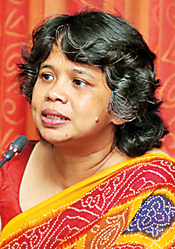Giving more voice to our lesser known languages

Dr. Romola Rasool
Sinhala, Tamil and English – are the languages commonly spoken in this country. But did you know there are several lesser known languages that are also in use? Dr. Romola Rasool, a Senior Lecturer at the University of Kelaniya’s Department of English Language and Teaching, dedicates most of her time and efforts to raise awareness about the language diversity of Sri Lanka and the importance of documenting and describing these minor languages.
The ‘Adivasi’ language, the language of the ‘Vanniyela-Eththo’ (‘Veddhas’): The Veddhas, or Vanniyela-Eththo as they prefer to be called, the descendants of Sri Lanka’s indigenous tribes, now numbering around 1,600 ( approximately 350 families) still speak this. They can be found in Mahiyangana and Dambana in the Uva Province.
Sri Lanka Portuguese (SLP): The language of the Portuguese Burghers is spoken by Portuguese descendants in Batticaloa and Trincomalee.
Sri Lanka Malay (SLM): The Lankan Malay population trace their origins to the Dutch and British colonial periods, when Malays were brought to the island as soldiers and workers. This diverse group has Javanese, Ambonese, Balinese, Buginese, and Malay ancestry.
Memoni : The Memoni language, of the Memon community from Northern India is spoken by about 1.5 million people in India, Pakistan, the UK, South Africa, and Sri Lanka.
Dawat-ni-Zaban : This is the language of the Sri Lankan Bohra community and is a dialect of Gujarati. The Dawoodi Bohras, a merchant group of Shii’a Muslims mainly live in Colombo and its suburbs. The community originated in the West Indian state of Gujarat.
Telugu: The Ahikuntaka people who live mainly in the North Central Province speak this Dravidian language that is spoken in Andhra Pradesh, South India. Descendants of a large South Indian nomadic tribe known as Koraver or Kuraver, they were referred to as Kuraveror Gypsies, but now prefer to be known as Telugu people.
Sindhi: This Indo-Aryan language is spoken by the Sindhi community, who number around 1,500 in Sri Lanka at present. Their ancestors came from Hyderabad in the Sindh region of Pakistan.
Rodi: The Rodi considered low-caste Sinhalese are descended from totemistic eastern Indian aboriginal hunting tribes who came to Sri Lanka along with the sacred Bo-sapling (the Sri Maha Bodhi in Anuradhapura) about 2,000 years ago. The Rodi dialect is disappearing as it is only spoken by the elders of the community.
A big obstacle to the preservation of such languages is the absence of state acknowledgment at the official level, Dr Rassool says, as there is no official platform for addressing and discussing minority rights and language preservation.
“The state institution which has a mandate to promote languages and carry out state language policy is the Ministry of National Co-existence, Dialogue, and Official Languages. The Department of Official Languages and the Official Languages Commission operate under this ministry,” she said.
“While the Department of Official Languages follows the Constitution of Sri Lanka and recognises the right to languages as a fundamental right, there is no explicit acknowledgment of these minorities or their languages.”
Dr Rassool hopes there will be increased awareness about the need for documenting and describing the lesser-spoken languages and for macro and micro level initiatives to support these efforts, especially among the younger generation.
European languages such as French and German were popular among the youth sometime ago, but right now many students are studying Asian languages like Chinese and Korean, says Dr Rassool.
Those interested in conducting research on the minor languages of Sri Lanka could contact Dr Rassool on email at: romola@kln.ac.lk
| Asian languages now preferred | |
 Dr. Dilrukshi Rathnayake Around 300 students have chosen Honours Degrees in foreign languages, and around 800 more have chosen foreign languages as one of the three subjects of their Bachelor of Arts degree, at the Kelaniya University, the head of its Modern Languages Department Dr. Dilrukshi Rathnayake told the Sunday Times. The foreign language degree programmes available right now include studies in Japanese, Korean, Chinese, German, French and Russian, with Chinese the most popular. “There is a big demand for Chinese and Korean languages because of future employment opportunities,” Dr. Rathnayake said. “The syllabi designed for language studies focus on developing the four skills of speaking, listening and comprehension, reading and comprehension, and writing. Culture, Literature, Languages in Tourism, Languages in International Relations and Translation Methods have been included as well.” “Foreign languages create opportunities on an international level. Tourism is one area where Sri Lankans can benefit. Many tourists in Sri Lanka today, do not speak English so communication through the tourist’s language is more effective,” she added. |


